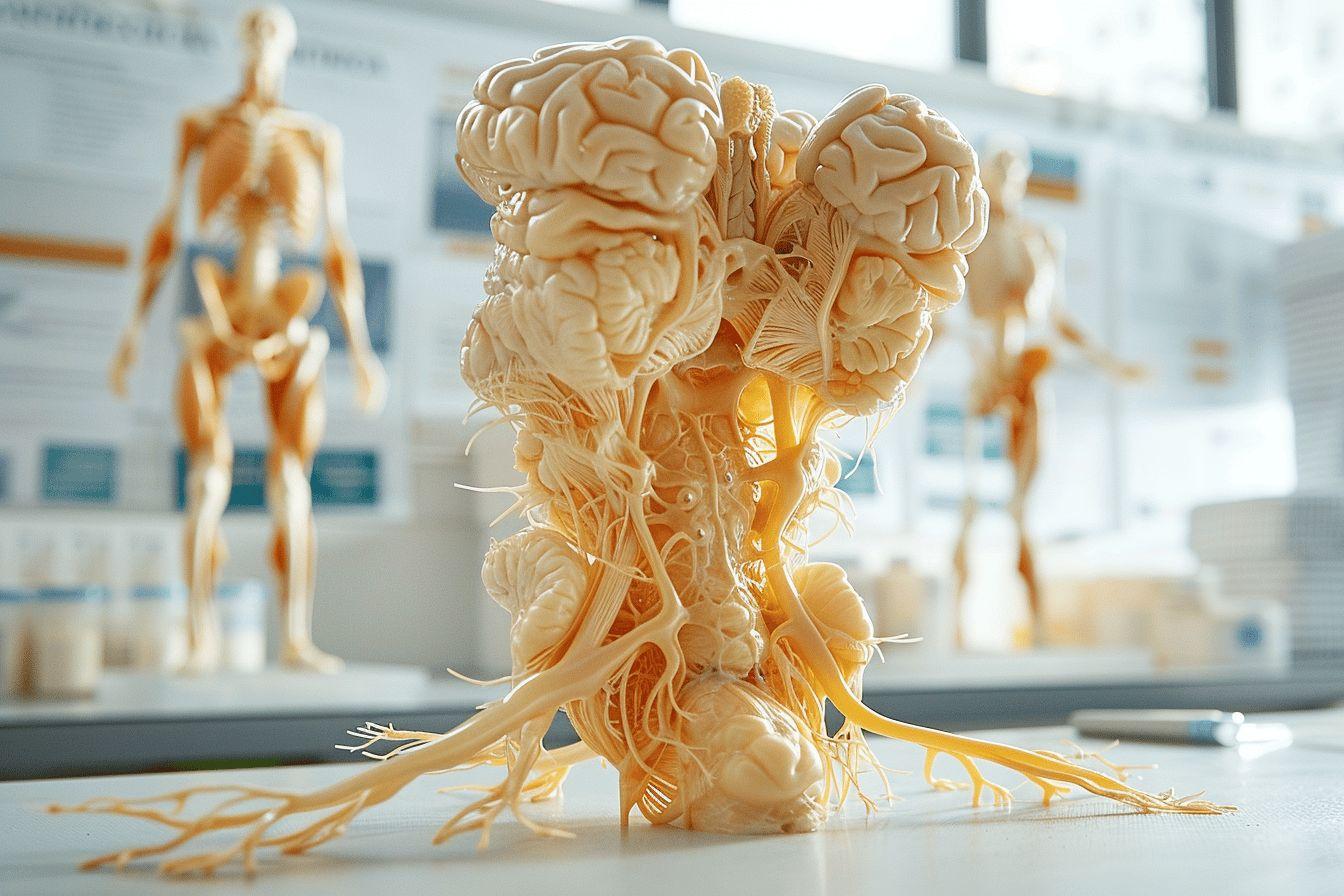The fascia, a fibrous membrane crucial to our anatomy, plays an essential role in musculoskeletal function. Here are its main characteristics:
- Dense lamellar structure composed mainly of collagen fibers
- Role of muscle support and protection
- Efficient transmission of muscle forces
- Contributes to body stability and movement coordination
- Implication in various pathologies such as plantar fasciitis
The fascia is a fascinating structure in the human body that plays a crucial role in our anatomy. This fibrous membrane, often overlooked, nevertheless deserves our full attention. Let's review together what an aponeurosis is, its essential functions, and its unique composition.
What is an aponeurosis?
An aponeurosis is a whitish fibrous membrane that envelops and separates muscles. It is part of the connective tissue of the human body and is composed primarily of collagen fibers. These membranes are present in various parts of our anatomy, forming a complex network that contributes to the proper functioning of our musculoskeletal system.
Aponeuroses are distinguished by their dense lamellar structure, which gives them great strength. They can vary in thickness and size depending on their location in the body. They are found in particular in the limbs, trunk, and even the skull.
It should be noted that aponeuroses are sometimes confused with fascia. Although these two structures are similar, the fascia are generally thicker and stronger. They play a specific role in transmitting muscle force and stabilizing joints.

Essential Roles of the Fascia in the Body
The fascia performs several crucial functions in our bodies. Here are the main roles of these fibrous membranes:
- Muscle support and protection
- Muscle force transmission
- Separation of muscle groups
- Maintaining muscle shape
- Contributing to blood and lymphatic circulation
One of the most important roles of the fascia is to efficiently transmit the forces generated by muscle contractions. They act like transmission belts, allowing muscles to function optimally. This function is particularly visible in areas such as the foot, where the plantar fascia plays a crucial role in the biomechanics of walking.
Furthermore, the fascia contributes to the overall stability of our body structure. By separating muscle groups, they allow for better coordination of movements and reduce friction between adjacent muscles. This organization improves the efficiency of our movements and prevents potential injuries.
Structure and Composition of the Fascia
The structure of the fascia is fascinating and complex. These membranes are composed primarily of collagen fibers, organized in overlapping layers. This arrangement gives the fascia their characteristic strength and ability to withstand significant tension.
Here is a summary table of the main components of an aponeurosis:
| Component | Function |
|---|---|
| Collagen Fibers | Strength and Structure |
| Elastic Fibers | Flexibility and Elasticity |
| Ground Substance | Hydration and Lubrication |
| Fibroblasts | Production and Maintenance of tissue |
The arrangement of collagen fibers in the fascia is not random. They are organized in specific patterns that optimize their ability to resist tensile forces. This organization contributes to the fascia's ability to efficiently transmit muscle forces while maintaining its structural integrity.
It should be noted that the composition of the fascia can vary slightly depending on its location in the body. For example, the fascia of the back, called the thoracolumbar fascia, has a particularly robust structure to withstand the significant stresses of this region.
Pathologies and treatments related to the fascia
Although the fascia are robust structures, they can sometimes be subject to pathologies. One of the most common conditions is plantar fasciitis, an inflammation of the plantar fascia that causes heel pain. This condition can be particularly disabling and often requires specific treatment.
Other pathologies can affect the fascia, such as:
- Dupuytren's contracture (palmar fascia)
- Iliotibial band syndrome
- Fascial contractures
- Fascial tears
Treatment for these conditions depends on their nature and severity. In many cases, a conservative approach is preferred, including rest, physiotherapy, and specific exercises. For example, to relieve heel pain related to a heel spur, gentle stretching of the plantar fascia can be beneficial. In more severe cases, surgery may be necessary. These procedures typically aim to release excessive tension in the affected fascia or repair a tear. It is crucial to consult a healthcare professional for an accurate diagnosis and a tailored treatment plan. The importance of plantar fascia in sports practice. The plantar fascia plays a crucial role in athletic performance and injury prevention. Their ability to efficiently transmit muscular forces is particularly important during intense physical activity. Athletes and coaches are paying increasing attention to these structures to optimize performance and reduce the risk of injury.
Maintaining and strengthening the fasciae is an integral part of many training programs. Specific exercises, such as dynamic stretching and proprioceptive work, can help maintain the flexibility and responsiveness of these fibrous membranes. This approach is particularly beneficial for preventing conditions such as plantar fasciitis in runners.
Note that certain massage and manual therapy techniques specifically target the fasciae. These methods aim to improve tissue flexibility and reduce excessive tension that can develop following intensive sports practice.
Finally, special attention must be paid to the body's overall muscular balance. Imbalances can cause abnormal tension on certain fasciae, increasing the risk of injury. This is why a well-designed training program often includes corrective exercises to prevent deformities and maintain optimal biomechanics.
By better understanding the role and structure of the fasciae, we can appreciate their crucial importance in our anatomy. These fibrous membranes, although often overlooked, are essential to our mobility and musculoskeletal health. Whether in daily life or in sports, taking care of our fasciae greatly contributes to our overall well-being and physical performance.





Leave a comment
This site is protected by hCaptcha and the hCaptcha Privacy Policy and Terms of Service apply.